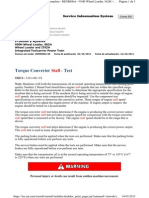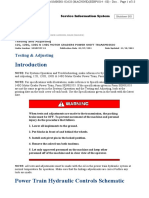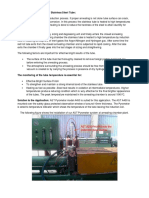100%(1)100% found this document useful (1 vote)
2K viewsWhy Does An Excavator Sometimes Have One Track Faster?
Why Does An Excavator Sometimes Have One Track Faster?
Uploaded by
Manuel GagnoThere are several potential reasons why an excavator may have one track moving faster than the other, including mechanical restrictions at the control levers, a worn undercarriage, a worn main hydraulic pump, a worn servo pump, one drive being stuck in high speed, worn track motors, a worn gearbox, or a leaking turning/swivel joint. Contamination is a leading cause of hydraulic failures and excavator tracking issues, as track motors are most susceptible due to being at the bottom of the circuit where debris collects.
Copyright:
© All Rights Reserved
Available Formats
Download as PDF, TXT or read online from Scribd
Why Does An Excavator Sometimes Have One Track Faster?
Why Does An Excavator Sometimes Have One Track Faster?
Uploaded by
Manuel Gagno100%(1)100% found this document useful (1 vote)
2K views3 pagesThere are several potential reasons why an excavator may have one track moving faster than the other, including mechanical restrictions at the control levers, a worn undercarriage, a worn main hydraulic pump, a worn servo pump, one drive being stuck in high speed, worn track motors, a worn gearbox, or a leaking turning/swivel joint. Contamination is a leading cause of hydraulic failures and excavator tracking issues, as track motors are most susceptible due to being at the bottom of the circuit where debris collects.
Original Description:
Final drive
Copyright
© © All Rights Reserved
Available Formats
PDF, TXT or read online from Scribd
Share this document
Did you find this document useful?
Is this content inappropriate?
There are several potential reasons why an excavator may have one track moving faster than the other, including mechanical restrictions at the control levers, a worn undercarriage, a worn main hydraulic pump, a worn servo pump, one drive being stuck in high speed, worn track motors, a worn gearbox, or a leaking turning/swivel joint. Contamination is a leading cause of hydraulic failures and excavator tracking issues, as track motors are most susceptible due to being at the bottom of the circuit where debris collects.
Copyright:
© All Rights Reserved
Available Formats
Download as PDF, TXT or read online from Scribd
Download as pdf or txt
100%(1)100% found this document useful (1 vote)
2K views3 pagesWhy Does An Excavator Sometimes Have One Track Faster?
Why Does An Excavator Sometimes Have One Track Faster?
Uploaded by
Manuel GagnoThere are several potential reasons why an excavator may have one track moving faster than the other, including mechanical restrictions at the control levers, a worn undercarriage, a worn main hydraulic pump, a worn servo pump, one drive being stuck in high speed, worn track motors, a worn gearbox, or a leaking turning/swivel joint. Contamination is a leading cause of hydraulic failures and excavator tracking issues, as track motors are most susceptible due to being at the bottom of the circuit where debris collects.
Copyright:
© All Rights Reserved
Available Formats
Download as PDF, TXT or read online from Scribd
Download as pdf or txt
You are on page 1of 3
Why Does An Excavator
Sometimes Have One Track
Faster?
There are several reasons why this happens, and conversely of
course, why one excavator travel motor is slow compared to the
other. Here are 8 that are the most relevant.
1. Mechanical restriction at the control levers
The first reason an excavator pulls to one side could be
down to a physical restriction that doesn’t allow the control
spool to open fully and let the drive get the full flow of oil
needed. This could be due to a stretched or unbalanced
link cable between the control lever in the cab and spool, or
simply a build up of debris around the control lever not
allowing it to open fully.
2. Worn undercarriage
Check the condition of the track, rollers and idlers. A seized
or collapsed bearing or tight track links can cause an
enormous amount of friction. This may appear to be an
excavator weak track but it is one track motor working
harder than the other giving a reduction in speed.
3. Worn main hydraulic pump
In smaller excavators there is one main pump that supplies
the oil to both track motors. Although there is one common
pump, the valve plate is effectively ‘split’ so it is perfectly
possible for one side of the valve plate to wear, causing
excessive case drain for one half of the circuit, meaning
one side of the machine will be getting more pressure and
flow than the other side. This causes excavator tracking to
:
one side. Larger excavators use dual pumps, a separate
pump for either side of the machine. A difference in
tracking speed could be down to one of the pumps being
damaged, causing excessive case drain and lack of
pressure/flow.
4. Worn servo pump
The servo pump provides the pressure and flow to release
the brake (if externally controlled) and operate the two
speed tracking. It is possible for a weak servo pump to not
have enough power to allow one brake to release properly
or only have enough power to engage one drive into two
speed.
5. One drive stuck in high speed
The most common style of excavator track motor is the
Axial Piston Motor with swash plate to give the function of
two speed tracking. If the two speed tracking circuit gets
damaged, it is possible for the two speed spool or piston in
one track motor to get stuck in the high speed position.
6. Worn motor
Over time it is inevitable that the track motors will wear.
Most commonly it is down to contaminated oil. Inside the
hydraulic motor there are metal components that have to
rotate against each other. To stop them making contact and
binding against each other there has to be a certain
amount of controlled oil leakage (case drain). If the oil is
contaminated, the debris will scratch the components in
the motor, causing excessive case drain. The oil now being
passed straight to the case drain line isn’t contributing to
the power of the motor, causing a reduction in speed and
excavator tracking problems. An easy check to see if the
track motor is generating too much case drain is to remove
the case drain line, measure the amount generated over
:
one minute and check against manufacturers
specifications.
7. Worn gearbox
A worn gearbox will add extra load to the hydraulic motor
and cause a reduction in speed. Check the condition of the
oil and condition of main bearings etc.
8. Leaking turning/swivel Joint
Between the upper structure and the undercarriage there is
a turning joint. This joint has multiple chambers that allows
the oil to flow from the upper structure to the
undercarriage. There are different pressures in each
chamber (flow/return are high pressure, 2 speed and brake
are servo pressure and case drain is low pressure). The
turning joint can leak internally, allowing the wrong
pressures to be in the wrong chambers. This can cause a
deviation in track speed and even catastrophic motor
failure if not fixed.
It is important to remember that contamination causes 90% of all
hydraulic failures and the majority of excavator tracking problems.
Track motors suffer the most because they are at the very bottom of
the circuit where all the sludge collects. Track motors also put the
greatest demand on the hydraulic pump compared to any other
function on the machine and people confuse the fact that a slow final
drive might be a symptom and not the cause of another problem
somewhere further up the circuit.
Click to find a replacement part and solve your excavator
tracking problems
:
You might also like
- Galion Grader Repair ManualDocument18 pagesGalion Grader Repair Manualtecnimaq71% (7)
- 15023506-Komatsu Service Pc300-7 Pc300lc-7 Pc350-7 Pc350lc-7 Shop Manual Excavator Workshop Repair BookDocument643 pages15023506-Komatsu Service Pc300-7 Pc300lc-7 Pc350-7 Pc350lc-7 Shop Manual Excavator Workshop Repair BookLinzaw Win100% (2)
- Bosch P7100 Manual Cummins - 230305 - 080017Document461 pagesBosch P7100 Manual Cummins - 230305 - 080017Juan Carlos SmidtNo ratings yet
- CAT 315L Hyd SystemTest & AdjDocument45 pagesCAT 315L Hyd SystemTest & AdjChaerul Umami88% (8)
- DAEWOO DOOSAN SOLAR 290LC-V EXCAVATOR Service Repair Manual PDFDocument98 pagesDAEWOO DOOSAN SOLAR 290LC-V EXCAVATOR Service Repair Manual PDFjfjkkskemmdm67% (3)
- Adjust The Valves and Injectors On A 3116Document2 pagesAdjust The Valves and Injectors On A 3116Deny Yusuf83% (12)
- Testing and AdjustingDocument20 pagesTesting and AdjustingAlexandra Yupanqui sarmiento100% (2)
- D6C Power Shift OperationDocument40 pagesD6C Power Shift OperationJhon AschNo ratings yet
- Bell TLB 315SG - 0110Document5 pagesBell TLB 315SG - 0110XG W0% (1)
- D8R T&aDocument37 pagesD8R T&aRajan Mullappilly100% (3)
- d6h Power TrainDocument55 pagesd6h Power TrainLuis Carlos Ramos100% (8)
- QuickServe Online - (3666087) B3.9, B4.5, B4.5 RGT, and B5.9 Service ManualDocument21 pagesQuickServe Online - (3666087) B3.9, B4.5, B4.5 RGT, and B5.9 Service Manualshashiraj50% (2)
- Testing and Adjusting: Troubleshooting The Transmission Hydraulic SystemDocument20 pagesTesting and Adjusting: Troubleshooting The Transmission Hydraulic SystemEdwin MelendezNo ratings yet
- Travel Counterbalance Valve: Systems OperationDocument10 pagesTravel Counterbalance Valve: Systems OperationRainer Lopez E100% (3)
- Volvo ECR58Plus ECR88PlusDocument12 pagesVolvo ECR58Plus ECR88PlusShailesh KhodkeNo ratings yet
- Engine Valve Lash - Inspect/Adjust: Shutdown SIS Previous ScreenDocument4 pagesEngine Valve Lash - Inspect/Adjust: Shutdown SIS Previous ScreenSteven Manuputty100% (1)
- Cat 936eDocument5 pagesCat 936eAlberto Ferradás100% (1)
- Tata Hitachi TWL3036 Wheel LoaderDocument2 pagesTata Hitachi TWL3036 Wheel Loaderpangapuvvu100% (2)
- AjusteDocument3 pagesAjusteAmy MurrayNo ratings yet
- Doosan DL450 Wheel Loader Service Repair Workshop ManualDocument10 pagesDoosan DL450 Wheel Loader Service Repair Workshop ManualManuals CE & Ag33% (3)
- Hyundai R450LC-7 Pilot CircuitDocument20 pagesHyundai R450LC-7 Pilot CircuitHai VanNo ratings yet
- Manual Cuminn 6btaDocument980 pagesManual Cuminn 6btaalfreditovictorian80% (5)
- Demo Ex 200-3 Rpair Manual PDFDocument6 pagesDemo Ex 200-3 Rpair Manual PDFSri Hartati100% (2)
- Shop Manual M300-III PDFDocument277 pagesShop Manual M300-III PDFBer Honza100% (6)
- PC350-8 Troubleshooting of Hydraulic and Mechanical System (H-Mode) PDFDocument34 pagesPC350-8 Troubleshooting of Hydraulic and Mechanical System (H-Mode) PDFHai VanNo ratings yet
- Bio102 Assignment 6Document3 pagesBio102 Assignment 6Daniel50% (2)
- Marine Diesel Engine Introduction and TheoryDocument84 pagesMarine Diesel Engine Introduction and TheoryVamshikrishna Kuruva100% (8)
- CS563Document44 pagesCS563Jose Luis Garcia BlancoNo ratings yet
- Earthmoving Landscaping - Excavators - Excavator 3.5 AC U35 3 AC - Operation ManualDocument98 pagesEarthmoving Landscaping - Excavators - Excavator 3.5 AC U35 3 AC - Operation ManualAlbertoNo ratings yet
- Testing and Adjunting Steering 950FDocument10 pagesTesting and Adjunting Steering 950FEsteban MunaresNo ratings yet
- Sistema de Operacion 14G HidraulicaDocument25 pagesSistema de Operacion 14G Hidraulicayeison100% (3)
- System OperationDocument82 pagesSystem OperationAntonio MejicanosNo ratings yet
- 14g Motor Grader 96u04298 07045 Machine Powered by 3306 Engine Sebp1263 02 Documentacion PDFDocument13 pages14g Motor Grader 96u04298 07045 Machine Powered by 3306 Engine Sebp1263 02 Documentacion PDFjude tally100% (1)
- Torque Converter Stall-TestDocument3 pagesTorque Converter Stall-TestMiguel Angel Moreno67% (3)
- D6R Ii Caterpillar Dozer Systems OperationDocument7 pagesD6R Ii Caterpillar Dozer Systems OperationBaron KasoziNo ratings yet
- Hydrostatic Drive SystemDocument25 pagesHydrostatic Drive SystemRenzo Miguel Manchego Davila89% (9)
- Service Training Malaga 374D/390D Hydraulic Excavators: Francis Mar 11Document18 pagesService Training Malaga 374D/390D Hydraulic Excavators: Francis Mar 11ait mimouneNo ratings yet
- New 7 Series: Tier II EngineDocument11 pagesNew 7 Series: Tier II EngineVânio CoelhoNo ratings yet
- 3066testing & AdjustingDocument129 pages3066testing & AdjustingjamcaNo ratings yet
- 12g, 120g, 130g & 140g Motor Graders Power Shift TransmissioDocument13 pages12g, 120g, 130g & 140g Motor Graders Power Shift TransmissioJuan Gonzalez100% (1)
- 920 & 930 WHEEL LOADERS POWER TRAIN Pruebas y AjustesDocument6 pages920 & 930 WHEEL LOADERS POWER TRAIN Pruebas y AjustesKarlOs Junco Sicha100% (1)
- Ajuste Valve Perins 1104Document5 pagesAjuste Valve Perins 1104josel204No ratings yet
- Hydraulic Pump Test and Adjust PDFDocument22 pagesHydraulic Pump Test and Adjust PDFservhiperu100% (1)
- Group 2 Electrical Circuit: Inlet M/ActDocument16 pagesGroup 2 Electrical Circuit: Inlet M/Actnikita100% (2)
- D8R Lubricant Viscosity PDFDocument37 pagesD8R Lubricant Viscosity PDFarfa ujianto100% (1)
- D41E, P-6 - Operation and MaintenanceDocument229 pagesD41E, P-6 - Operation and MaintenanceJEFERSON100% (1)
- System Operation Steering 950FDocument20 pagesSystem Operation Steering 950FEsteban MunaresNo ratings yet
- 428c Backhoe Loader General InfDocument8 pages428c Backhoe Loader General InfShimplementheIhoThuRaphero100% (2)
- Solar 130lc-V Hydraulic SystemDocument289 pagesSolar 130lc-V Hydraulic SystemHai Van83% (6)
- D8r Hydraulic SystemDocument69 pagesD8r Hydraulic SystemKibrom hiluf0% (2)
- Escaner Ht-8a ExcavadorasDocument7 pagesEscaner Ht-8a ExcavadorasBrahian Mijael Garrado GonzalesNo ratings yet
- D8R TRACK-TYPE TRACTOR 9EM00001-UP (MACHINE) POWERED BY 3406C Engine (SEBP2536 - 130) - DocumentationDocument29 pagesD8R TRACK-TYPE TRACTOR 9EM00001-UP (MACHINE) POWERED BY 3406C Engine (SEBP2536 - 130) - Documentationdedy imranNo ratings yet
- Hydraulic CicuitDocument88 pagesHydraulic CicuitEko Sunaryo100% (2)
- Backhoe LoaderDocument24 pagesBackhoe LoaderAdrian NNo ratings yet
- Manual Maintenance Lubrication Champion 710 740a 750 780a Motor Graders Service Engine Components SystemsDocument30 pagesManual Maintenance Lubrication Champion 710 740a 750 780a Motor Graders Service Engine Components SystemsRoussel Florez ZuloagaNo ratings yet
- 216B 226B 232B 242B Skid Steer Loader BXM00001-04224 (MACHINE) POWERED BY 3024C Engine (SEBP3770 - 65) - Systems & Components 15 UBA PDFDocument6 pages216B 226B 232B 242B Skid Steer Loader BXM00001-04224 (MACHINE) POWERED BY 3024C Engine (SEBP3770 - 65) - Systems & Components 15 UBA PDFubaldo caraballoNo ratings yet
- OmegaDocument2 pagesOmegaATHOLSCHWARZNo ratings yet
- Https Sisred - Venequip.com Sisweb Sisweb Techdoc Techdoc PrintDocument11 pagesHttps Sisred - Venequip.com Sisweb Sisweb Techdoc Techdoc PrintJose Corcega britoNo ratings yet
- d6t Track-Type Tractor STD, XL Differential Steering Gct00001-Up (Machine) Powered by c9 Engine (Sebp4963 - 44) - Hydraulic System TroubleshootingDocument10 pagesd6t Track-Type Tractor STD, XL Differential Steering Gct00001-Up (Machine) Powered by c9 Engine (Sebp4963 - 44) - Hydraulic System TroubleshootingDouglas GomesNo ratings yet
- Testing and Adjusting HIDRAULICDocument34 pagesTesting and Adjusting HIDRAULICJorge A. Artica100% (1)
- Hydraulic System: Pantalla AnteriorDocument4 pagesHydraulic System: Pantalla AnteriorDiego VicenteNo ratings yet
- Power Train TroublshootingDocument4 pagesPower Train TroublshootingGamalielNo ratings yet
- Ratio Analysis and Working Capital Statement Analysis: Summer Training Project Report On DSCLDocument99 pagesRatio Analysis and Working Capital Statement Analysis: Summer Training Project Report On DSCLvisual_merchandisingNo ratings yet
- Transmission & Distribution of Air: Fan SystemsDocument36 pagesTransmission & Distribution of Air: Fan Systemsvalerio.garibayNo ratings yet
- Enzyme PracticalDocument11 pagesEnzyme PracticalShezzaNo ratings yet
- MN - 2019 08 20Document24 pagesMN - 2019 08 20mooraboolNo ratings yet
- 6..resistivity LogDocument29 pages6..resistivity LogSagar DadhichNo ratings yet
- Grid-Connect PV Design ProjectDocument12 pagesGrid-Connect PV Design ProjectAli KaiserNo ratings yet
- MF1547Electric Panel PDFDocument24 pagesMF1547Electric Panel PDFAhmad Ali NursahidinNo ratings yet
- 6.776 High Speed Communication Circuits S-Parameters and Impedance TransformersDocument35 pages6.776 High Speed Communication Circuits S-Parameters and Impedance TransformersdunyaninbaskentiNo ratings yet
- CT SizingDocument24 pagesCT SizingGanesh SantoshNo ratings yet
- Dokumen - Tips - Case 821f Tier 4 Wheel Loader Service Repair Manual 1583049126Document29 pagesDokumen - Tips - Case 821f Tier 4 Wheel Loader Service Repair Manual 1583049126Rytis SiaulysNo ratings yet
- CHEN 623 Problems Old Examination Problems: 1.: (P + A /V) (V B) RTDocument34 pagesCHEN 623 Problems Old Examination Problems: 1.: (P + A /V) (V B) RTZohaib Ali0% (1)
- Tension Wire ChartDocument1 pageTension Wire Chartlaspsieca100% (1)
- Micom P126 and P127 Directional/Non Directional Overcurrent RelaysDocument2 pagesMicom P126 and P127 Directional/Non Directional Overcurrent RelaysAONLANo ratings yet
- Berimapazibemex Troy Reed Magnetic Motor KugotirDocument4 pagesBerimapazibemex Troy Reed Magnetic Motor KugotirHélder PereiraNo ratings yet
- Whats The Difference Between Enthalpy and EntropyDocument12 pagesWhats The Difference Between Enthalpy and EntropyShahzaib BukhariNo ratings yet
- CompositesDocument26 pagesCompositesMark Anthony Asañez BrianNo ratings yet
- Forest Harvest Residues Available in Eastern Canad PDFDocument32 pagesForest Harvest Residues Available in Eastern Canad PDFGeo SpatialistNo ratings yet
- Bright Annealing Process of Stainless S Teel TubeDocument2 pagesBright Annealing Process of Stainless S Teel TubeAgniva DuttaNo ratings yet
- THE FULL PAPER by DR Sab Safi of SDT Drives PDFDocument10 pagesTHE FULL PAPER by DR Sab Safi of SDT Drives PDFmohanNo ratings yet
- Heat Shrinkable TubingDocument1 pageHeat Shrinkable TubingAlex RamirezNo ratings yet
- Science Class 10 Notes For Carbon and Its CompoundsDocument4 pagesScience Class 10 Notes For Carbon and Its Compoundsmanal ahemadNo ratings yet
- FPTS 120L & 150L & 200L & 300L Thermosiphon Systems: Installation ManualDocument24 pagesFPTS 120L & 150L & 200L & 300L Thermosiphon Systems: Installation ManualZain ShariffNo ratings yet
- BREEAM Full ExampleDocument16 pagesBREEAM Full Examplequenti.chevrierNo ratings yet
- Well Test Operator: S.SivarajDocument3 pagesWell Test Operator: S.Sivarajjohn M100% (2)
- Competence in CementDocument24 pagesCompetence in CementJackson VuNo ratings yet
- Agitated Thin-Film EvaporatorsDocument4 pagesAgitated Thin-Film Evaporatorsزهرة النرجس100% (4)
- Lian Sidorov and Matti Pitkanen - Paranormal PhenomenaDocument10 pagesLian Sidorov and Matti Pitkanen - Paranormal PhenomenaAndross580No ratings yet
- OFC QualityDocument2 pagesOFC QualityAditya PrakashNo ratings yet

























































































